Lone Worker Compliance Law in Canada: Everything You Need to Know in 2025
📌 Table of Contents
- Introduction
- What is Lone Worker Compliance Law?
- Defining Lone Workers Under Canadian Law
- The Legal and Business Case for Compliance
- Legal Framework in Canada
- Federal Regulations
- Provincial and Territorial Laws
- Provincial Regulations at a Glance
- Province-Specific Requirements
- British Columbia
- Alberta
- Saskatchewan
- Manitoba
- Ontario & Nova Scotia
- Quebec
- New Brunswick
- Other Provinces and Territories
- Employer Requirements
- Hazard Assessments
- Written Procedures
- Communication Systems
- Safety Training
- Documentation
- Industry-Specific Challenges
- Oil & Gas, Construction, and Utilities
- Retail and Hospitality
- Healthcare
- Professional Services
- Security
- Legal Consequences of Non-Compliance
- Common Compliance Challenges
- Awareness Gaps
- Operational Difficulties
- Technology Limitations
- Cultural Resistance
- Administrative Burden
- Frequently Asked Questions
- Compliance Checklist & Best Practices
- Conclusion
Introduction
Have you ever considered what happens when your employees work without direct supervision or immediate assistance? This question keeps many Canadian business leaders awake at night—and with good reason.
Every day across Canada, millions of employees perform their duties alone. From night-shift security guards patrolling empty buildings to home care nurses visiting patients in their residences, these lone workers deliver essential services while facing unique safety challenges. Understanding lone worker compliance law has never been more important for Canadian employers.
For safety managers and executives, the stakes couldn’t be higher. When a maintenance technician falls from a ladder with no one around, or a convenience store clerk faces an armed robber at 2 AM, the time until help arrives can mean the difference between a close call and a tragedy.
Beyond the human element, the regulatory consequences of violating lone worker compliance laws are significant. Organizations face potential fines, increased insurance premiums, and even criminal charges under Canada’s “Westray law” when lone worker protections fall short.
At Protelec Checkmate, we’ve seen firsthand how proper adherence to lone worker compliance law protects both employees and organizations. With over 25 million people working alone regularly across North America, understanding these regulations becomes a critical business imperative.
Grab a coffee (you might need it—safety regulations aren’t exactly thriller novel material), and let’s dive into everything Canadian employers need to know about lone worker compliance law. Whether you’re managing a team of remote technicians or overseeing late-night retail operations, this guide will help you navigate the complex web of requirements while keeping your most valuable asset—your people—safe and sound.
What is Lone Worker Compliance Law and Why Does It Matter?
Key Takeaways:
- Legal Definition: A lone worker is someone who works without direct supervision and cannot be seen or heard by another person.
- Compliance Necessity: Bill C-45 (the “Westray law”) permits criminal charges against organizations that fail to protect employees.
- Business Impact: Beyond legal requirements, proper lone worker protection improves morale, reduces turnover, and enhances your reputation.
Defining Lone Workers Under Canadian Law
Under Canadian occupational health and safety legislation, a “lone worker” is generally defined as someone who works without direct supervision and cannot be seen or heard by another person. These employees face unique risks that standard workplace safety measures may not adequately address.
Lone worker situations include:
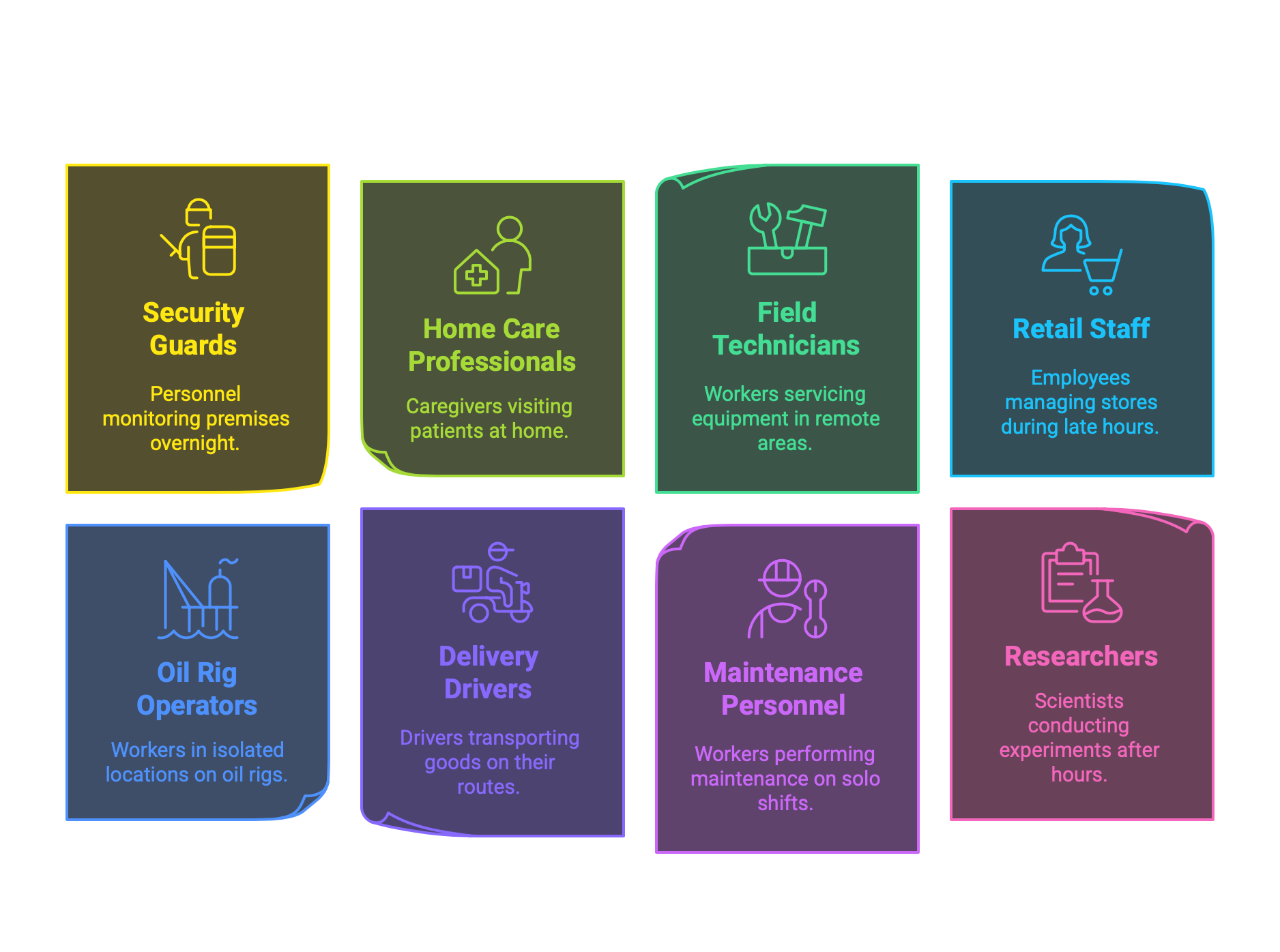
The Legal and Business Case for Compliance
Lone worker compliance law refers to the legal framework designed to protect employees who work alone. These regulations vary by province but share common principles of employer responsibility. The impact of these laws on your organization is multifaceted:
- Legal Requirements: Canadian employers have a legal “duty of care” to protect all workers, including those working alone. Bill C-45 (the “Westray law”) permits criminal charges against organizations and directors who fail to take reasonable steps to protect employees. This amendment to Canada’s Criminal Code holds organizations and individuals directing work criminally liable for workplace safety failures.
- Financial Implications: Regulatory fines for non-compliance with lone worker laws can be substantial. Beyond penalties, organizations face higher Workers’ Compensation premiums, legal expenses, and reputational damage that can impact financial performance for years.
- Human Impact: Without proper safety measures mandated by lone worker compliance laws, workers face significantly higher risk. A worker who slips and breaks a leg in an empty warehouse may wait hours for help. A social worker facing an aggressive client during a home visit needs immediate backup options.
- Operational Benefits: Companies that effectively comply with lone worker protection laws experience tangible advantages: higher morale, reduced turnover, fewer incidents, and enhanced reputation as an employer of choice.
Despite these compelling reasons, many Canadian organizations still address lone worker safety reactively rather than as a strategic priority. This approach creates unnecessary legal exposure in today’s complex regulatory environment.
Legal Framework for Lone Worker Safety in Canada
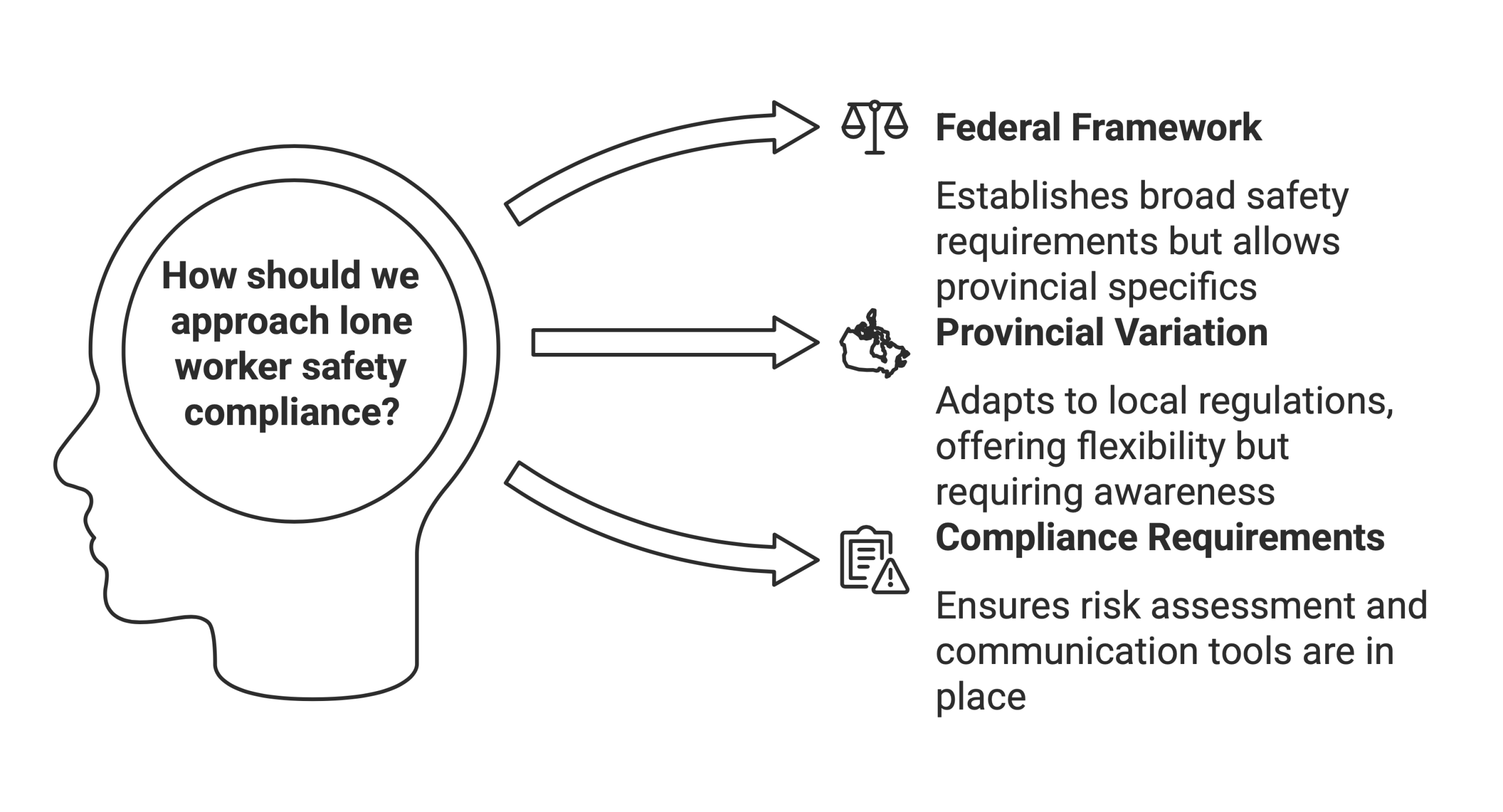
Federal Regulations: The Foundation of Canadian Lone Worker Law
The Canada Labour Code (Part II) and the Canada Occupational Health and Safety Regulations (COHSR) establish broad worker safety requirements. While no specific federal law prohibits working alone, Section 124 of the Labour Code requires that “every employer shall ensure that the health and safety at work of every person employed by the employer is protected.”
Think of it as the federal government saying, “We expect you to keep your workers safe, but we’ll let the provinces handle the nitty-gritty details.” It’s like your parent telling you to “drive safely” without specifying exactly how fast to go or which route to take.
The Canadian Centre for Occupational Health and Safety (CCOHS) provides guidance on lone working scenarios, but enforcement of lone worker laws primarily occurs at the provincial level.
Provincial and Territorial Lone Worker Laws: The Enforcement Layer
Each province and territory implements its own Occupational Health and Safety (OHS) legislation with varying approaches to lone worker protection. Here’s your cross-Canada tour of lone worker compliance laws—no passport required, but you might want to take notes:
Provincial Regulations at a Glance
| Province | Specific Lone Worker Regulation | Key Requirements | Unique Features |
| British Columbia | Yes – Section 4.21 of BC OHSR | Written procedures, regular check-ins, final shift checks | Grant’s Law for retail workers |
| Alberta | Yes – OHS Code | Hazard assessments, communication plans, documentation | Detailed requirements for emergency communication |
| Saskatchewan | Yes | Risk identification, prohibitions for high-risk activities | “Reasonably practicable” control measures |
| Manitoba | Yes | Worker involvement, reliable monitoring | Safe work procedures must be implemented |
| Ontario | No – General Duty | “Every precaution reasonable in the circumstances” | Enforcement can be rigorous despite general nature |
| Quebec | Yes – Article 322 | “Efficient surveillance” for isolated environments | Continuous or intermittent monitoring |
| New Brunswick | Yes | Code of Practice for Working Alone Regulations | Regular reviews required |
| Nova Scotia | No – General Duty | Similar to Ontario’s approach | Relies on general protection requirements |
| Newfoundland | Yes | Written procedures, annual reviews | Focus on documentation |
| Other Territories | Varies | General duty frameworks | Best practices recommended |
British Columbia: Comprehensive Lone Worker Law
WorkSafeBC implements specific measures under Sections 4.21 and 4.22 of their OHS Regulation:
- Written procedures for checking lone worker well-being
- Mandatory regular check-ins with frequency appropriate to risk level
- Communication intervals appropriate to risk level
- Mandatory final check at shift end
- Enhanced protection for late-night retail under “Grant’s Law”
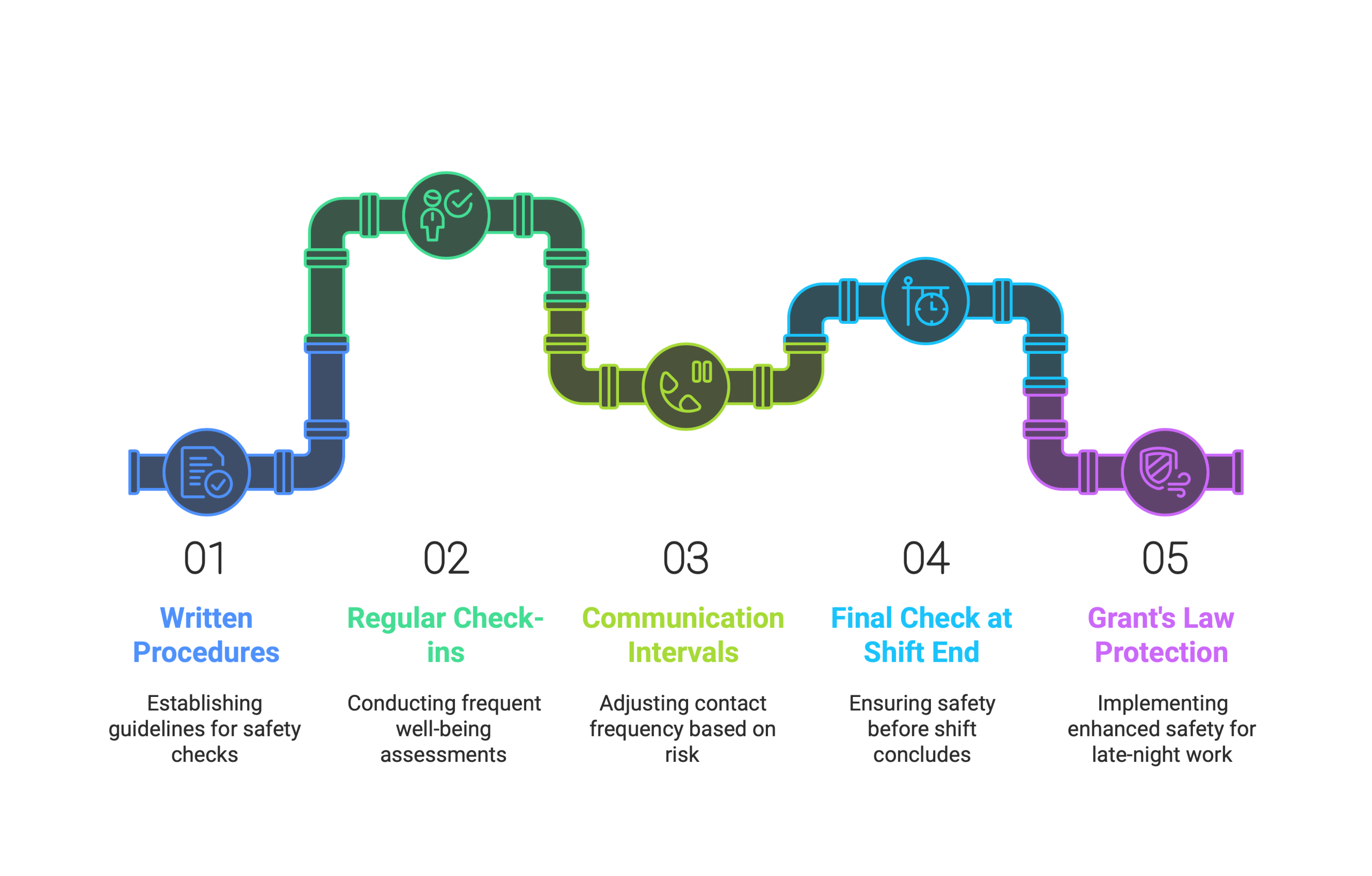
Compliance strategies for BC lone worker law:
- Develop written procedures using WorkSafeBC templates
- Implement reliable check-in systems customized to risk levels
- Train both lone workers and monitoring personnel
- Schedule annual procedure reviews
- For retail operations, install physical barriers or implement buddy systems for late shifts
BC takes lone worker safety law seriously—very seriously. WorkSafeBC mandates written procedures for checking lone workers’ well-being under Section 4.21 of the BC OHSR. BC isn’t messing around when it comes to protecting vulnerable workers.
Real World Case: Grant’s Law
Following the tragic death of gas station attendant Grant De Patie, who was killed during a “gas-and-dash” incident, BC implemented “Grant’s Law.” This legislation requires protective barriers or a second worker during late-night retail shifts, plus mandatory fuel pre-payment. This case fundamentally changed how BC regulates lone worker safety in retail environments.
Alberta: Detail-Oriented Lone Worker Compliance Requirements
Alberta’s OHS Code features comprehensive lone worker provisions:
- Specific hazard assessments for lone work scenarios
- Regular contact scheduled according to risk level
- Mandatory effective emergency communication
- Thorough documentation requirements
Compliance strategies for Alberta lone worker law:
- Conduct and document formal hazard assessments for each lone worker role
- Establish detailed communication plans with defined check-in schedules
- Implement reliable emergency communication systems
- Train all personnel on procedures and equipment
- Develop responsive protocols for missed check-ins
- Maintain comprehensive documentation
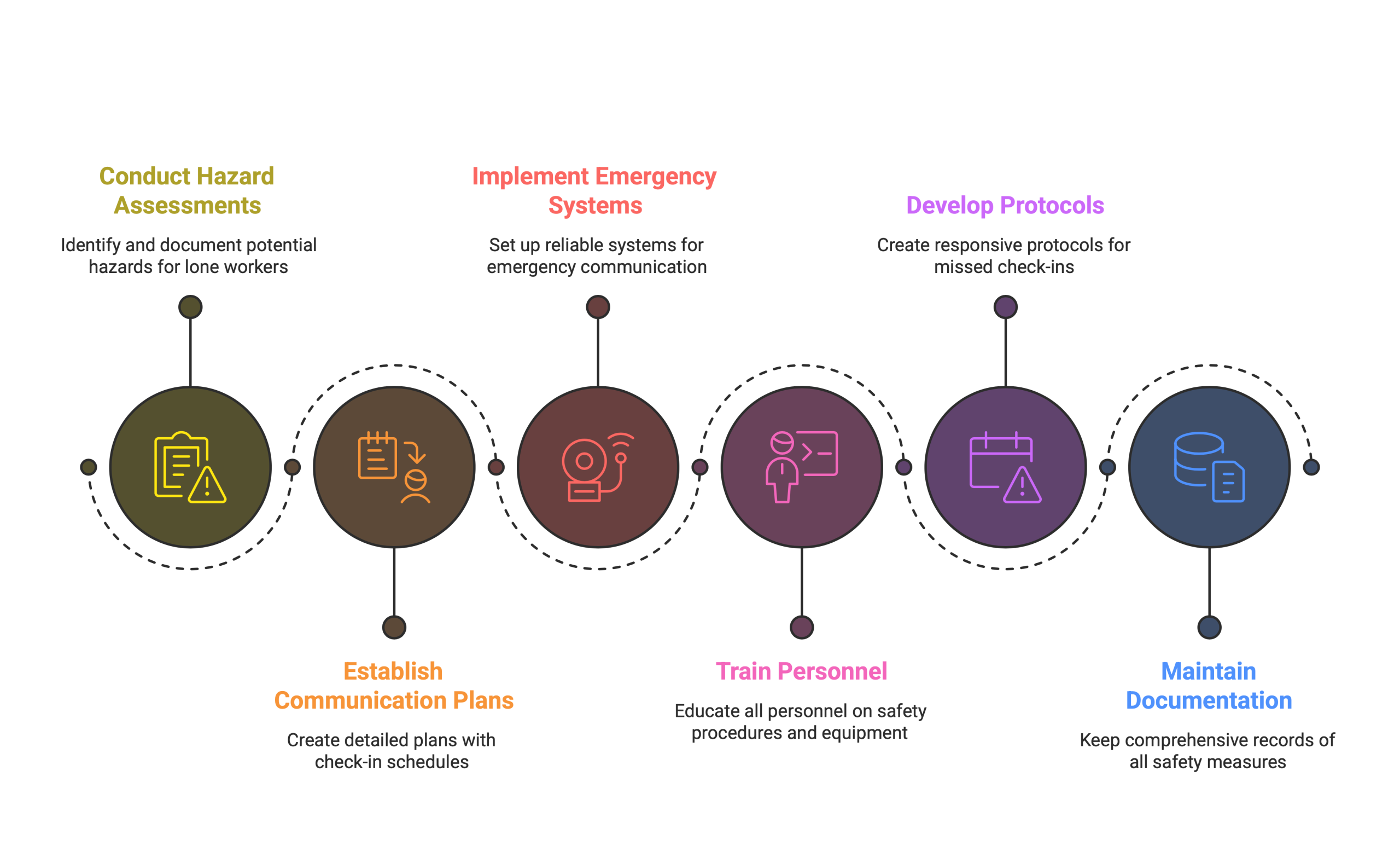
Alberta doesn’t mess around with details in their lone worker compliance laws. Their OHS Code requires formal hazard assessments specifically for lone work situations and maintaining contact at appropriate intervals. Documentation and effective emergency communication systems are mandatory. Think of Alberta as that meticulous friend who creates color-coded spreadsheets for vacation planning—they want everything documented and accounted for.
Saskatchewan: Practical Approach to Lone Worker Protection
Saskatchewan defines working alone as being the only worker at a site where assistance isn’t readily available during emergencies:
- Risk identification with all reasonably practicable steps to eliminate or reduce risks
- Prohibition of certain high-risk activities for lone workers
- Established communication procedures
Compliance strategies for Saskatchewan lone worker law:
- Assess each lone working scenario for specific hazards
- Implement appropriate safeguards matched to risk level
- Consider scheduling second workers for high-risk tasks
- Document both risk assessments and control measures
- Provide thorough worker training on emergency procedures
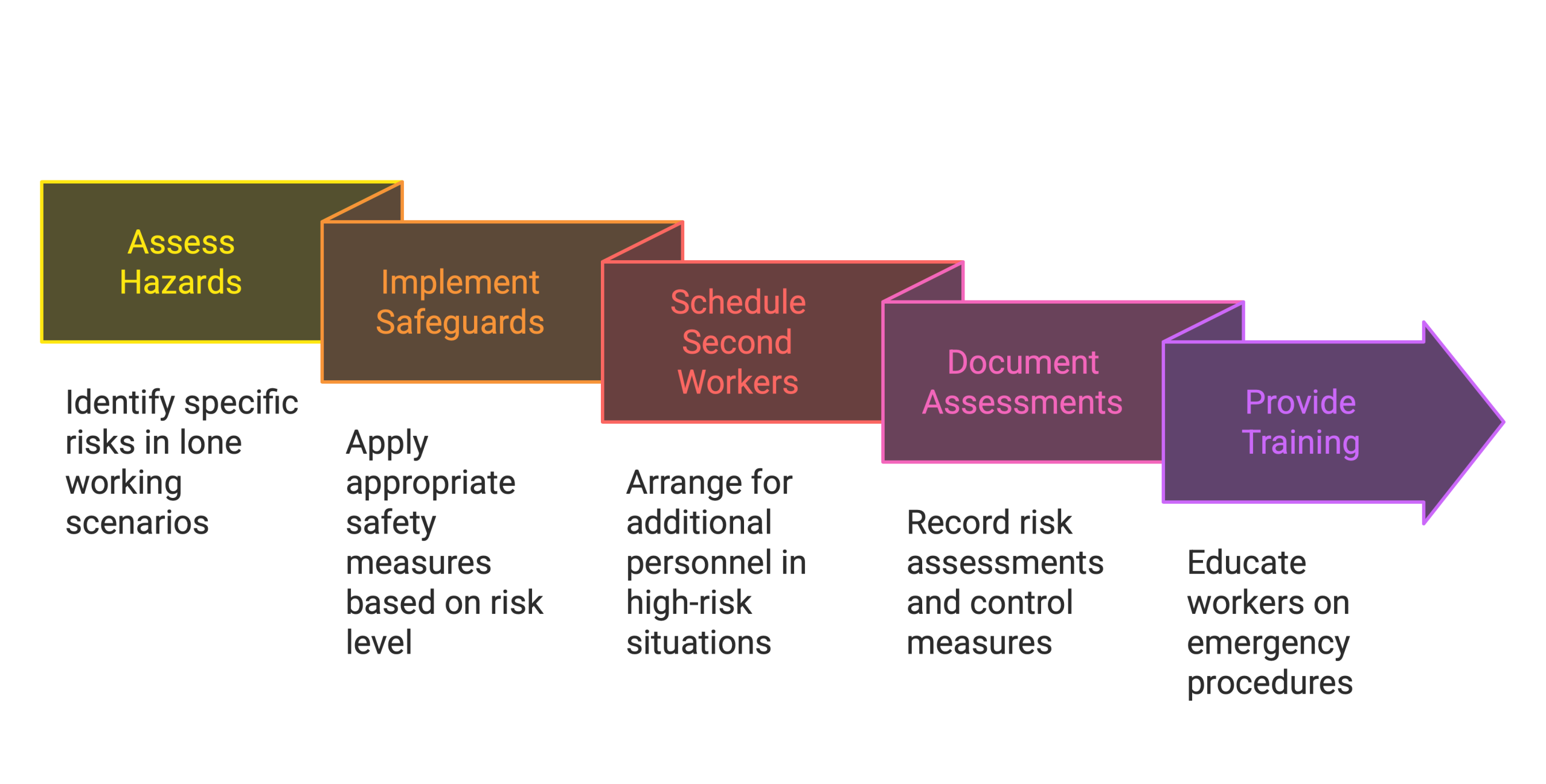
Manitoba: Collaborative Lone Worker Safety Planning
Manitoba emphasizes worker involvement in safety planning:
- Requires employers to develop and implement safe work procedures to mitigate identified risks for lone workers
- Risk identification for lone workers
- Development of procedures with worker input
- Implementation of reliable monitoring methods
Compliance strategies for Manitoba lone worker law:
- Engage lone workers in creating safety procedures
- Provide appropriate communication tools with backup options
- Test communication systems regularly under actual conditions
- Document worker involvement in the planning process
Ontario and Nova Scotia: The General Duty Approach to Lone Worker Safety
IMPORTANT NOTE:
While Ontario and Nova Scotia lack specific lone worker regulations, this doesn’t mean employers face reduced obligations. The general duty clause creates substantial responsibility, and enforcement can be just as rigorous as in provinces with detailed requirements.
While lacking specific lone worker regulations, both Ontario and Nova Scotia apply general duty clauses in their respective OHS Acts. In Ontario, Section 25(2)(h) of the OHSA creates substantial obligations:
- Employers must “take every precaution reasonable in the circumstances” for worker protection
- This broad requirement applies fully to lone worker scenarios
- Enforcement can be rigorous despite the general nature of the clause
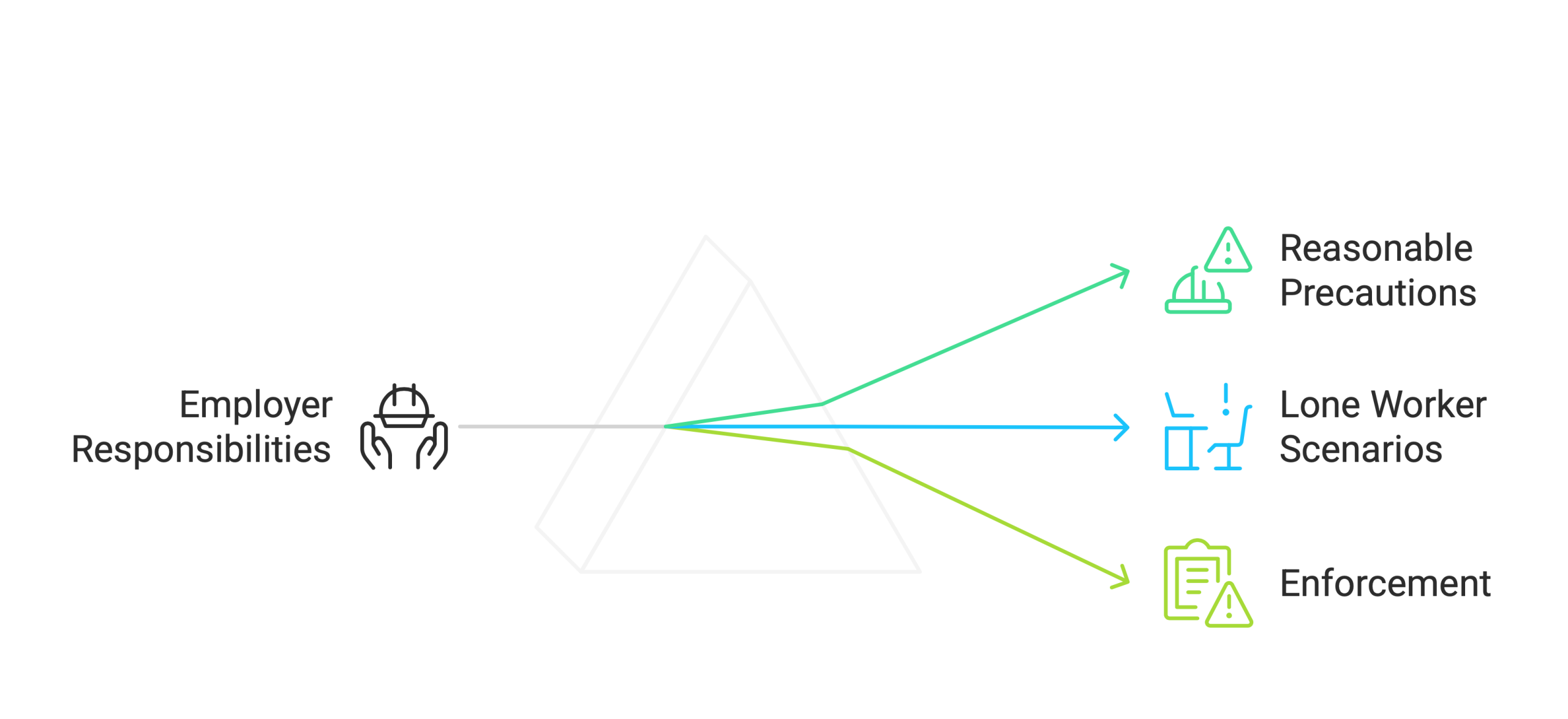
Compliance strategies for Ontario and Nova Scotia lone worker law:
- Apply due diligence practices comparable to provinces with specific regulations
- Conduct comprehensive hazard assessments for lone work
- Implement appropriate safeguards including reliable communication systems
- Ensure emergency response plans address lone worker scenarios
- Document all safety measures implemented
Ontario takes a different approach to lone worker law. While their OHS Act lacks specific “working alone” provisions, employers must still “take every precaution reasonable in the circumstances for the protection of a worker” under Section 25(2)(h). It’s as if Ontario is saying, “We’re not going to tell you exactly how to protect your lone workers, but you’d better do it—or else.” This general duty applies fully to lone worker protection.
Quebec: The Lone Worker Surveillance Mandate
Quebec’s distinctive approach centers on Article 322’s surveillance requirement:
- Workers in isolated environments where they cannot request assistance must have “efficient surveillance”
- This surveillance can be continuous or intermittent, depending on risk level
Compliance strategies for Quebec lone worker law:
- Identify truly isolated work scenarios in your operations
- Implement appropriate monitoring methods matched to isolation level
- Integrate surveillance into your emergency response procedures
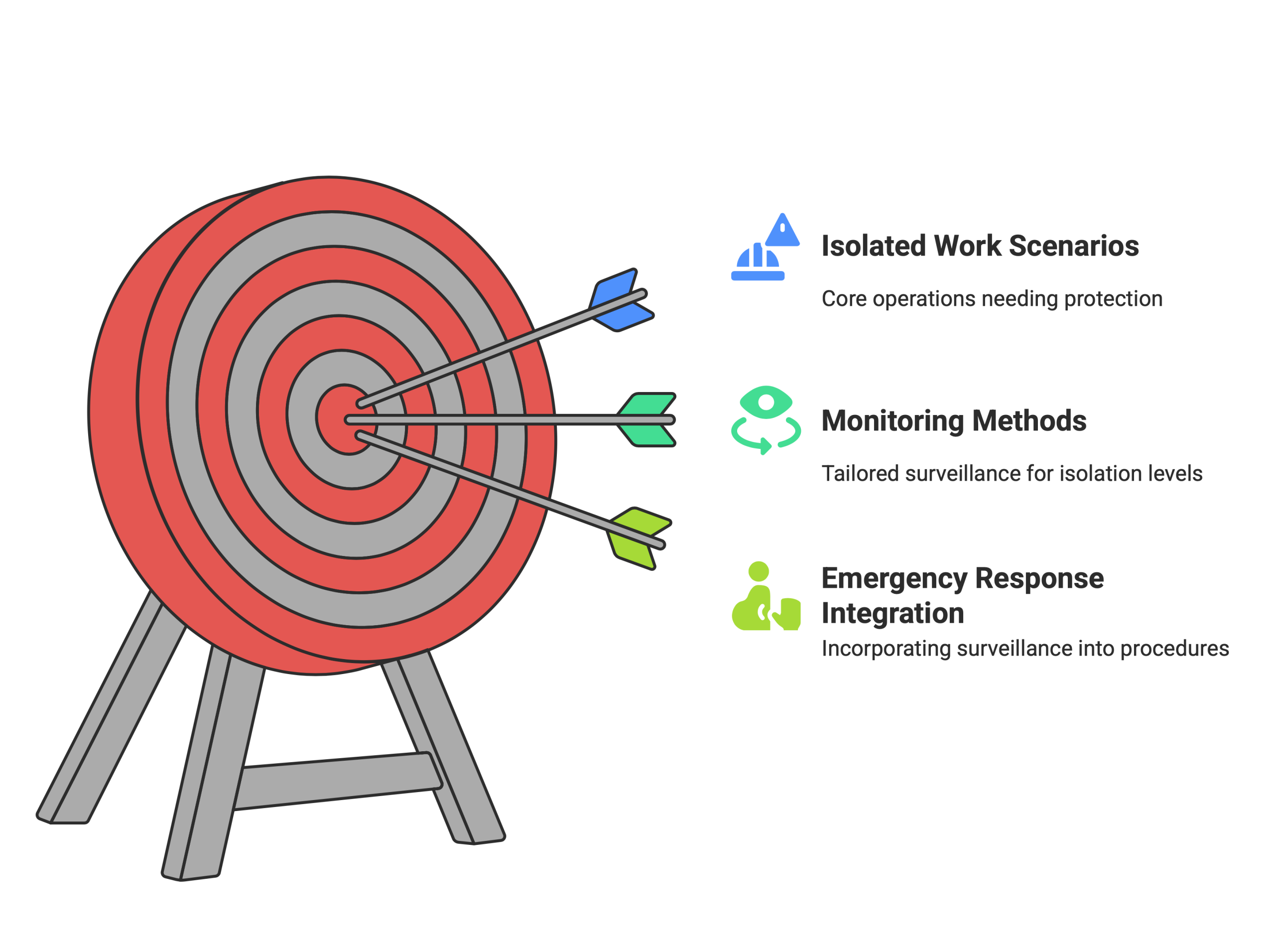
Leave it to Quebec to add some European flair to lone worker safety regulations. Article 322 of their Act Respecting Occupational Health and Safety requires “an efficient means of surveillance, whether continuous or intermittent” for workers in isolated environments where they cannot request assistance. Quebec essentially says, “If someone’s working alone where they can’t call for help, you need to be watching out for them.”
New Brunswick: Procedural Focus on Lone Worker Protection
NB requires specific documentation and review:
- Formal “Code of Practice for Working Alone Regulations” obligating employers to provide safety and supervision to lone workers
- Written procedures for lone worker protection
- Annual reviews of these procedures
- Regular communication and monitoring
Compliance strategies for NB lone worker law:
- Develop role-specific written procedures
- Schedule and document annual reviews
- Implement and enforce appropriate check-in protocols
- Maintain records of procedures and review activities
NB takes a formal approach to lone worker law, requiring employers to establish a detailed “Code of Practice for Working Alone” with specific safety measures and contact information. It’s like having to write a safety autobiography for your lone workers.
Newfoundland and Labrador: Procedural Focus on Lone Worker Protection
NL requires specific documentation and review:
- Written procedures for lone worker protection
- Annual reviews of these procedures
- Regular communication and monitoring
Compliance strategies for NL lone worker law:
- Develop role-specific written procedures
- Schedule and document annual reviews
- Implement and enforce appropriate check-in protocols
- Maintain records of procedures and review activities
Other Provinces and Territories: General Duty Frameworks for Lone Workers
These jurisdictions primarily rely on general duty clauses rather than specific lone worker regulations:
- Employers must ensure healthy and safe workplaces
- “Reasonable precautions” standard applies to lone workers
Compliance strategies for lone worker law:
- Implement best practices even without explicit requirements
- Develop voluntary lone worker policies
- Conduct hazard assessments and implement controls
- Document safety measures to demonstrate due diligence
Your business location significantly impacts your specific compliance requirements under lone worker law. Multi-province operations require familiarity with regulations in each jurisdiction where lone workers operate.
What Lone Worker Compliance Laws Require From Employers
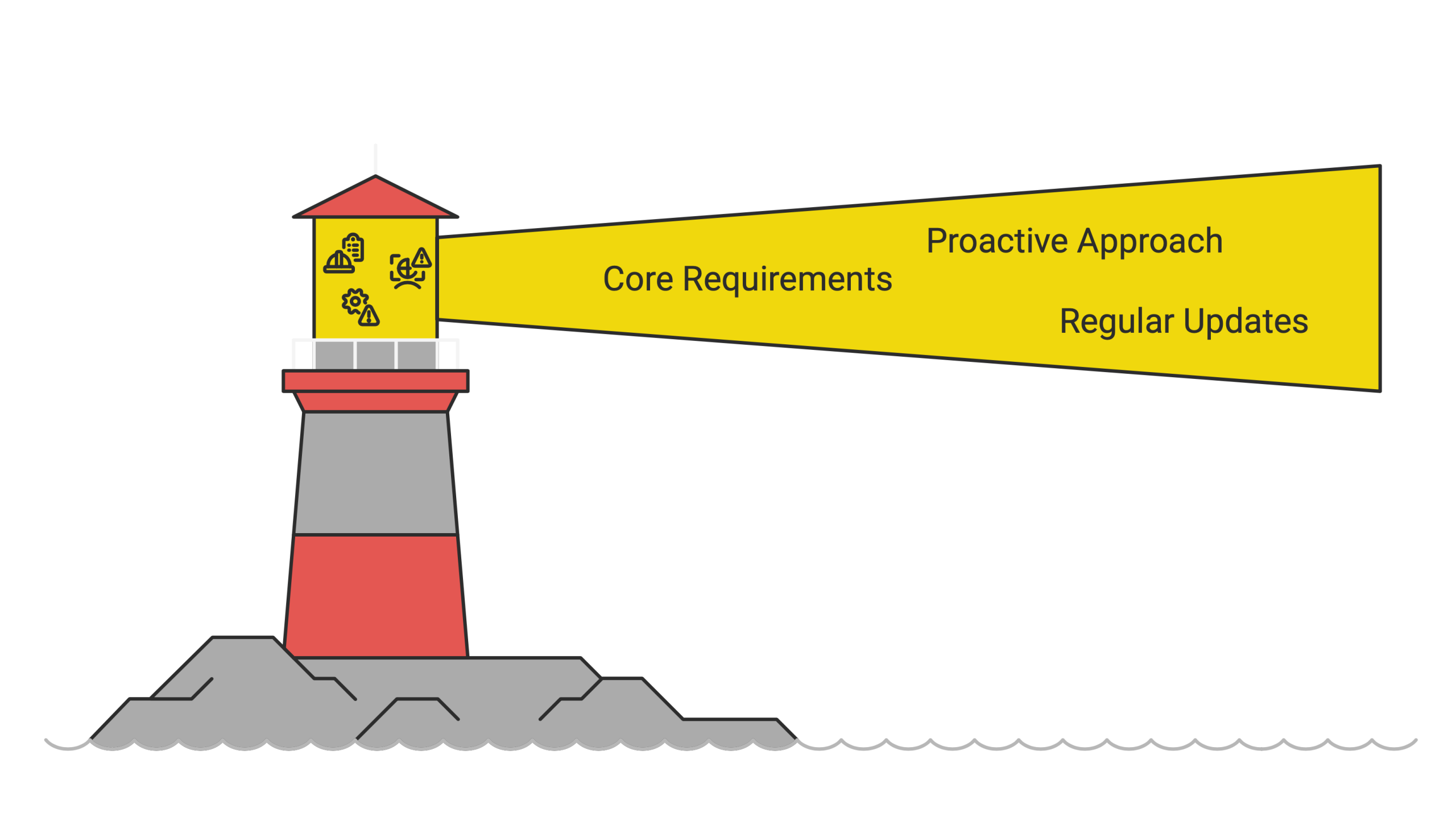
Key Takeaways:
- Five Core Requirements: Despite regional variations in lone worker compliance law, the legal obligations for lone workers are clear and consistent: employers must implement hazard assessments, written procedures, communication systems, safety training, and documentation.
- Proactive Approach: Employers must identify risks before incidents occur rather than reacting to problems after the fact.
- Regular Updates: Compliance is not a one-time effort but requires ongoing review and adjustment as conditions change.
Despite regional variations in lone worker compliance law, certain fundamental responsibilities apply to employers across Canada:
1. Conduct Hazard Assessments: Know Your Enemy
You can’t protect against dangers you haven’t identified—and lone worker compliance laws require this first step. Effective protection starts with thorough hazard assessments specific to lone working scenarios. Consider:
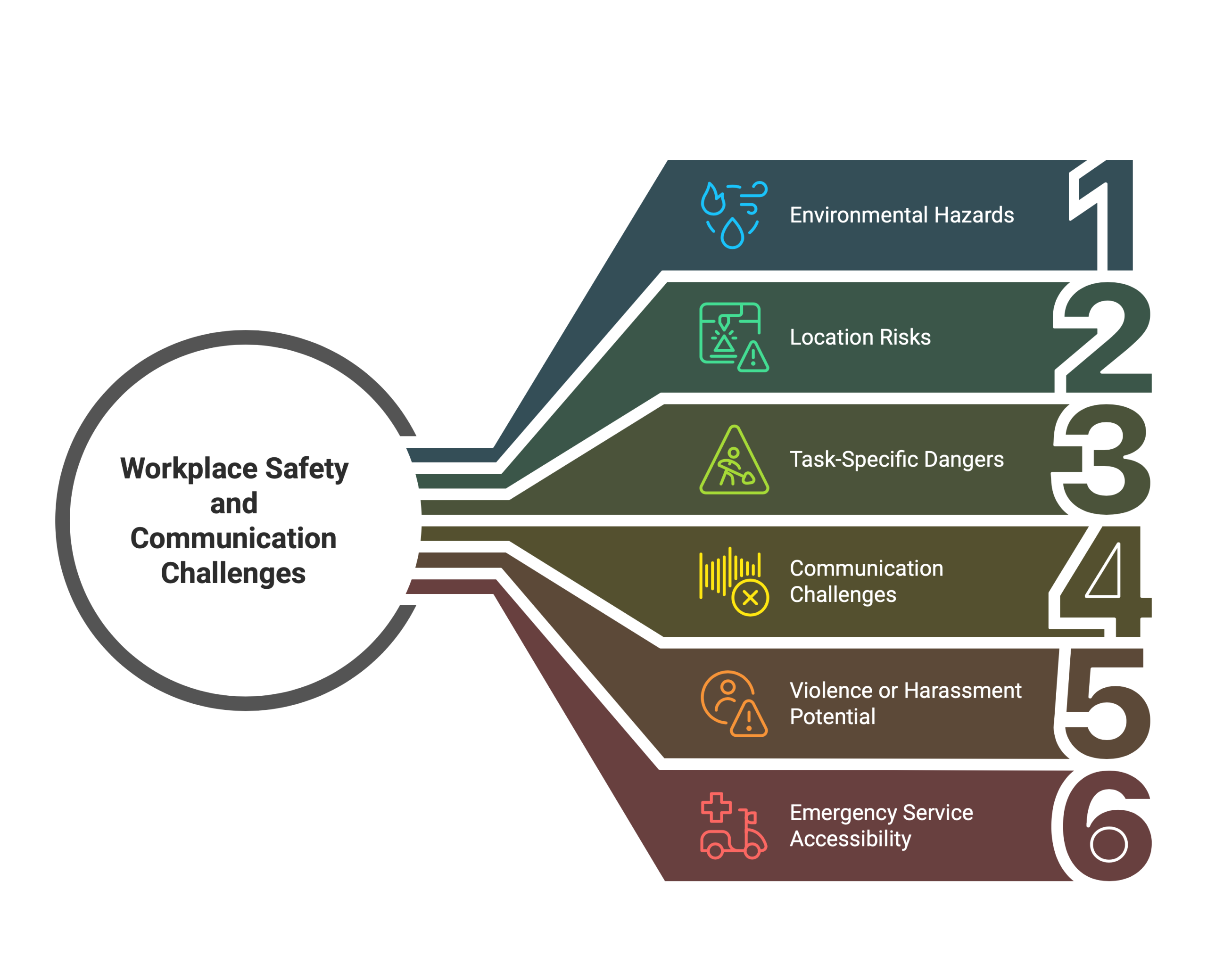
Think of hazard assessment as safety reconnaissance—you’re scouting the territory before sending in your lone workers. Without properly identifying risks, protective measures will inevitably fall short of legal requirements.
2. Develop Written Working Alone Procedures: Create Your Playbook
Based on your hazard assessment, Canadian lone worker compliance laws generally require documented procedures addressing:
- Check-in protocols with appropriate frequencies
- Communication methods tailored to the work environment
- Emergency response plans with clear escalation paths
- Personal protective equipment requirements
- Training provisions and competency verification
- Activities prohibited when working alone
These procedures shouldn’t gather dust in a binder—they need to be living documents that everyone knows and follows. Make them practical, accessible, and regularly reinforced through training and supervision to meet legal requirements.
3. Implement Reliable Communication Systems: The Lifeline Required by Law
For lone workers, communication isn’t just about productivity—it’s a lifeline mandated by lone worker compliance law. Ensure they have appropriate methods to maintain contact and signal for help:
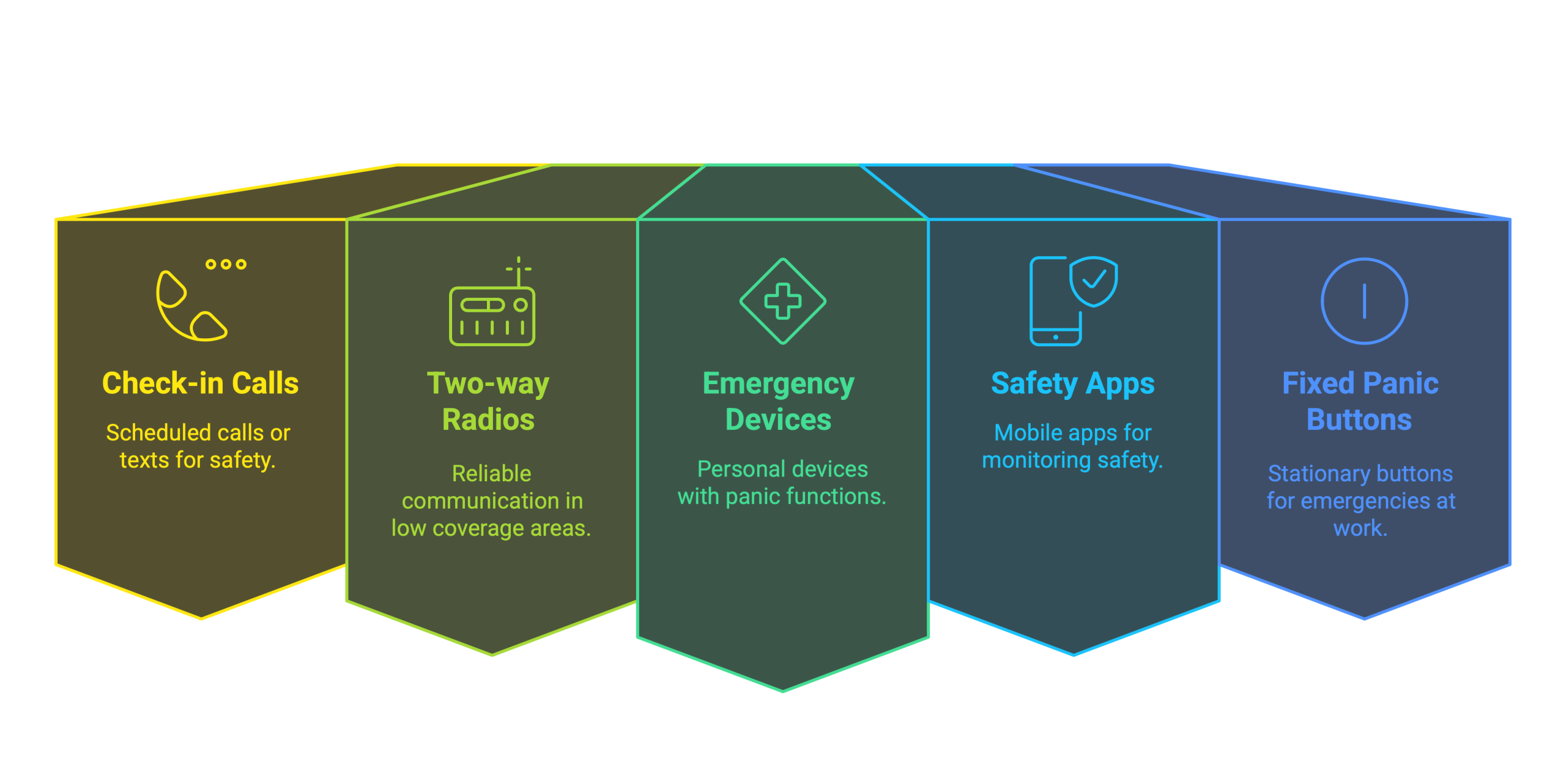
- Scheduled check-in calls or texts (the digital equivalent of “Marco Polo”) are one of the most basic methods of work alone monitoring, ensuring consistent safety verification throughout the shift.
- Two-way radios in areas with poor cell coverage (old school but reliable)
- Personal emergency devices with panic functions (the “help me now” button)
- Mobile safety apps with monitoring capabilities (technology to the rescue)
- Fixed panic buttons at stationary work locations (when all else fails)
The communication system must match the actual work environment as required by law. Urban solutions often fail in rural or remote locations, so testing under real conditions is essential for legal compliance.
4. Deliver Lone Worker Safety Training: Knowledge That Saves Lives and Satisfies Law
Even sophisticated safety systems fail if people lack proper training—which is why lone worker compliance laws mandate it. Ensure workers and supervisors receive instruction on:
- Recognizing and reporting hazards unique to working alone
- Proper use of communication devices and all safety features
- Emergency response protocols and decision-making authority
- First aid and self-protection techniques
- De-escalation strategies for public-facing roles
Training should combine classroom learning with practical exercises and regular refreshers to maintain readiness and satisfy legal requirements.
5. Document Everything: Creating Your Compliance Record Under Lone Worker Law
Thorough documentation serves multiple purposes—demonstrating compliance with lone worker laws, identifying patterns, and supporting continuous improvement. Maintain records of:
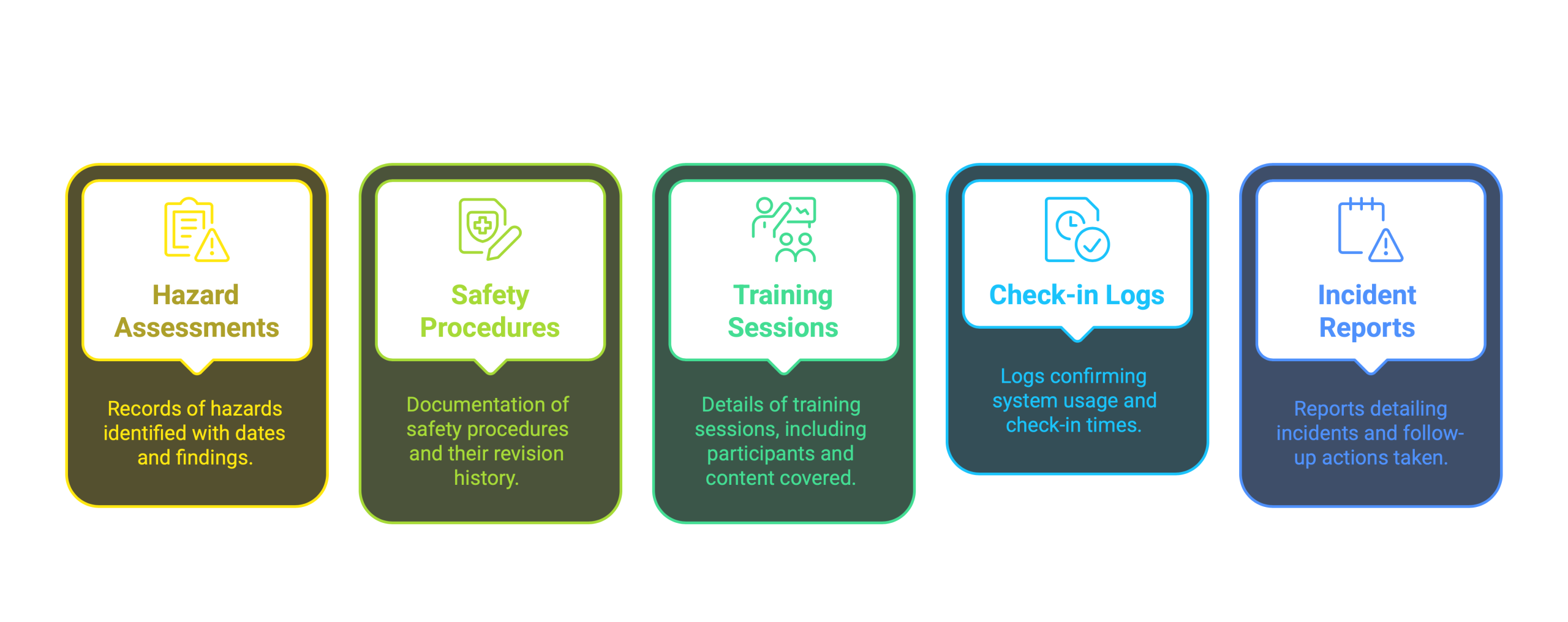
- Hazard assessments with dates and findings
- Safety procedures with revision history
- Training sessions including participants and content
- Check-in logs confirming system usage
- Incident reports with follow-up actions
These records provide critical protection if questions arise after an incident and help identify opportunities to strengthen your safety program over time. Many provinces explicitly require this documentation under their lone worker compliance laws.
Industry-Specific Lone Worker Compliance Law Challenges
Key Takeaways:
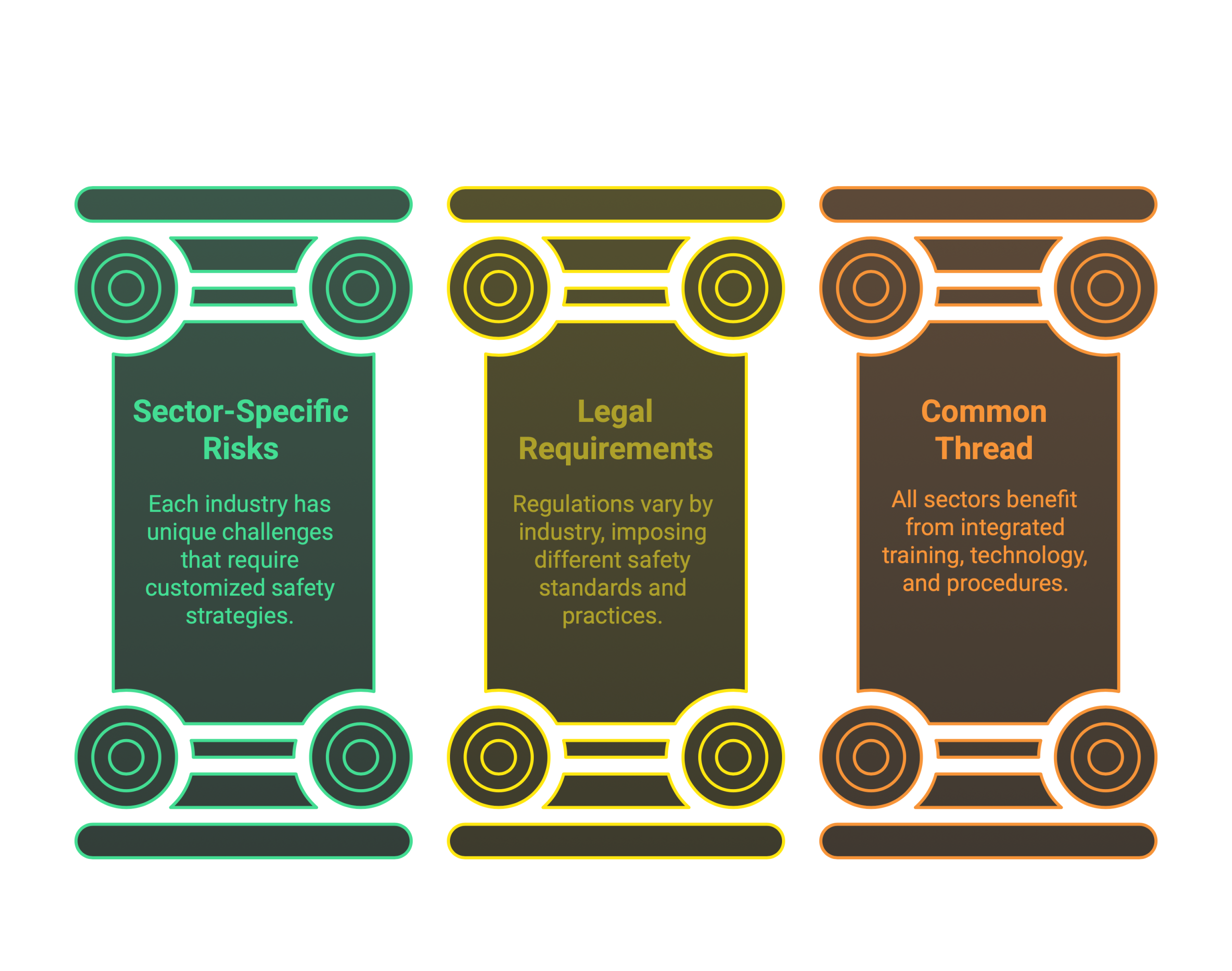
Different sectors face unique lone worker protection requirements under Canadian law. Industry-specific solutions deliver more effective compliance.
Oil and Gas, Construction, and Utilities: Extreme Isolation Demands Robust Legal Compliance
Real World Case:
A western Canadian oil company implemented CheckMate after a technician spent 14 hours trapped with a broken leg at a remote well site—his scheduled check-in being the only reason he was discovered before hypothermia became life-threatening. This case illustrated the life-or-death importance of proper lone worker law compliance.
These sectors operate in some of Canada’s most challenging environments:
- Work sites hours from emergency services
- Extreme weather creating additional hazards
- Hazardous materials and equipment
- Minimal or non-existent cellular coverage
- Wildlife and environmental risks
Industry-specific compliance solutions: Companies in these sectors typically require satellite communication devices, intrinsically safe monitoring equipment for hazardous environments, and stringent check-in protocols to meet legal requirements. Advanced solutions include geofencing that automatically tracks workers entering high-risk areas and increases monitoring frequency accordingly.
Retail and Hospitality: Public Exposure Creates Lone Worker Vulnerability
Retail and hospitality workers, particularly during evening shifts, face distinct risks addressed by specific lone worker laws in some provinces:
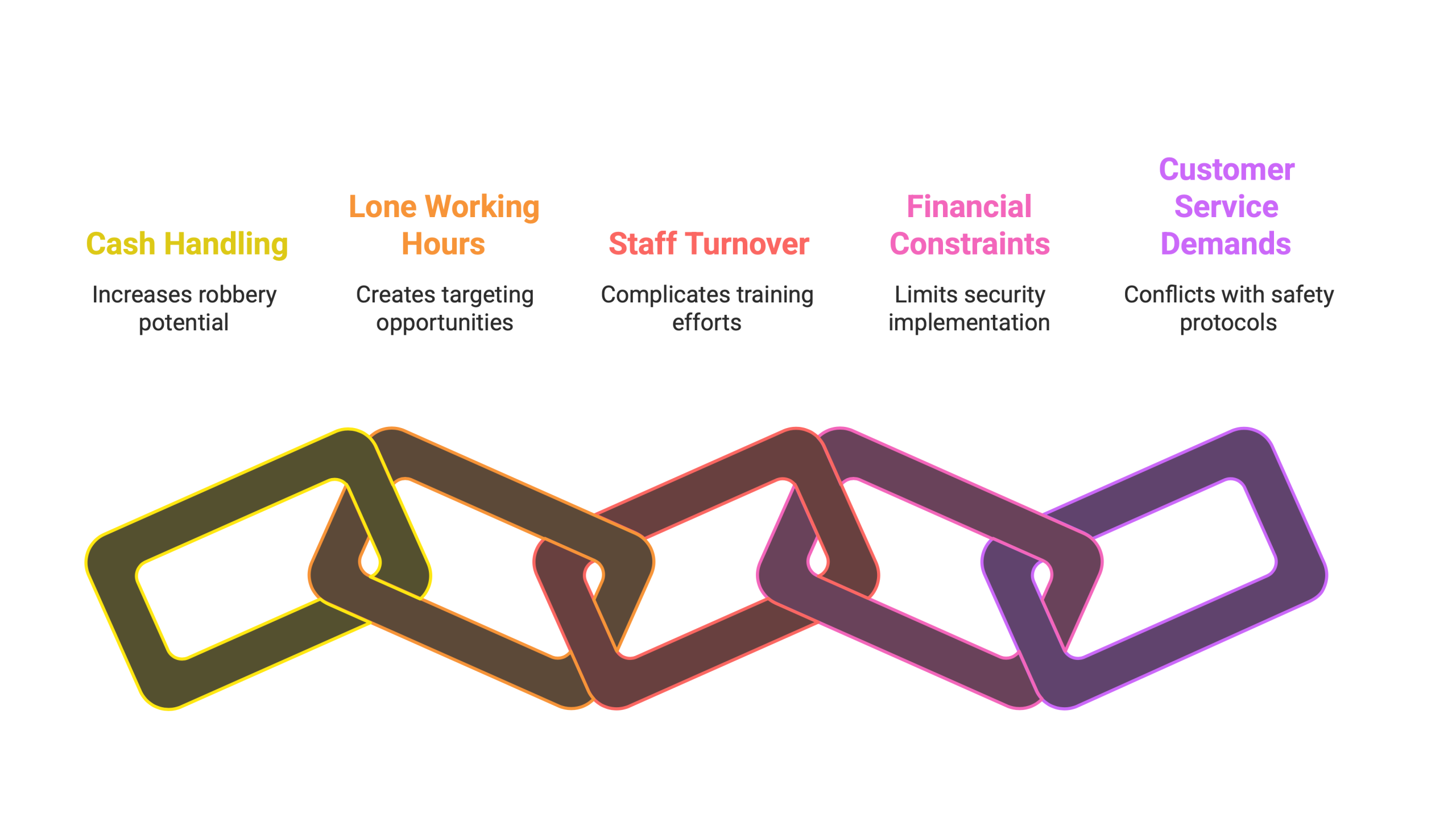
- Cash handling increasing robbery potential
- Predictable lone working hours creating targeting opportunities
- High staff turnover complicating training efforts
- Financial constraints for small retailers implementing security
- Customer service demands sometimes conflicting with safety protocols
Industry-specific compliance solutions: Effective retail and hospitality protection typically includes visible security monitoring, emergency alert systems, cash management procedures, and clear safety protocols as required by provincial laws like Grant’s Law in BC. High-risk locations may require physical barriers or window service during overnight hours. Many businesses implement “virtual buddy” systems connecting stores to central monitoring locations during vulnerable periods.
Healthcare: Uncontrolled Environments Amplify Legal Risks
Healthcare workers making home visits encounter unique challenges under lone worker compliance law:
- Working in environments outside employer control
- Unpredictable patient or family behaviors
- Medical equipment transport creating additional vulnerability
- Patient privacy considerations affecting monitoring options
- Patient care priorities sometimes overshadowing self-protection
Industry-specific compliance solutions: Healthcare organizations typically implement pre-visit risk assessments, coded check-in systems, GPS-enabled safety apps, and comprehensive training on situational awareness to meet legal obligations. Some provide staff with discreet personal alarms or check-in applications that can be triggered without escalating tense situations.
A social services agency equipped field staff with our duress feature, allowing a case worker during an increasingly hostile home visit to trigger a silent alert that brought police assistance without escalating the confrontation—potentially preventing violence while meeting their legal duty of care.
Professional Services: The Overlooked Lone Workers Under the Law
Professionals like real estate agents, insurance assessors, and field consultants often face unrecognized risks under lone worker compliance law:
- Meeting strangers in unfamiliar locations
- Traveling between sites throughout the day
- Working non-standard hours
- Operating with minimal supervision
- Working in industries without established safety cultures
Industry-specific compliance solutions: Forward-thinking professional service firms increasingly implement mobile check-in applications for high-risk activities like property showings to meet their legal duty of care. Client pre-screening protocols, colleague notification systems for meetings, and clear check-in expectations during travel help mitigate risks without disrupting client service while satisfying legal requirements.
Security: When Protectors Need Legal Protection as Lone Workers
Security personnel epitomize lone working challenges under Canadian safety laws:
- Intentional placement in vulnerable situations
- Responsibilities requiring investigation of suspicious activity
- Overnight shifts maximizing isolation
- Expectations to respond to emergencies without backup
- Geographic dispersion complicating monitoring
Industry-specific compliance solutions: Leading security companies implement patrol tracking systems, checkpoint-based monitoring, dedicated emergency communication channels, and automated inactivity alerts to meet legal requirements. Many now utilize body-worn cameras and GPS-enabled devices providing both protection and documentation during incidents. These measures have become industry standard following high-profile cases of violence against lone security personnel.
Legal Consequences of Non-Compliance with Lone Worker Law
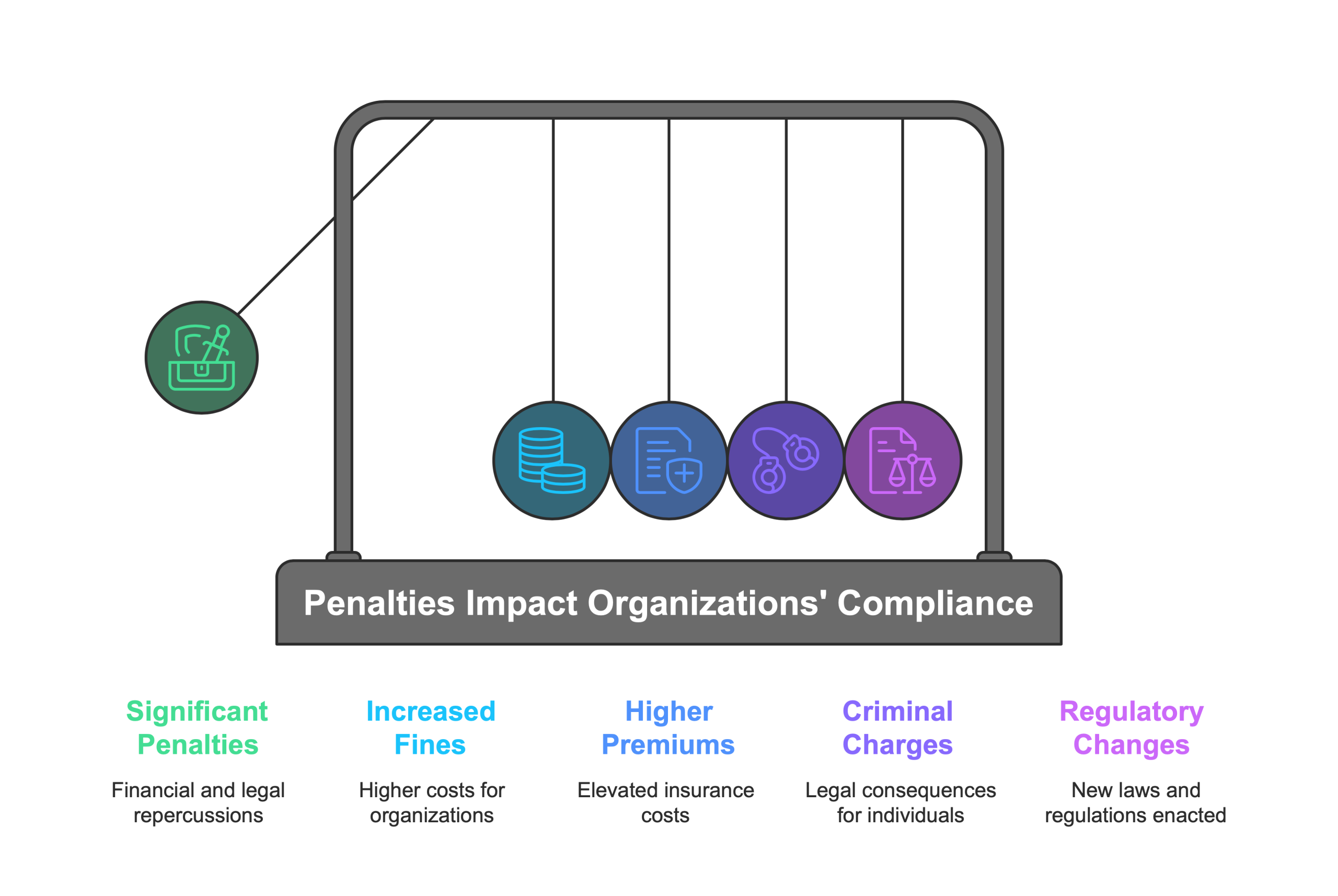
Several well-documented cases illustrate the serious consequences when lone worker protection falls short of legal requirements:
Case Study: Alberta Security Guard
An Alberta security guard working alone at a construction site was attacked and sexually assaulted after her emergency call went to voicemail. The security company received a $90,000 fine for inadequate hazard assessment and communication procedures under Alberta’s OHS Act. The investigation revealed the company had not conducted a proper hazard assessment for the lone assignment and lacked effective communication procedures.
Gas station attendant Grant De Patie’s death during a “gas-and-dash” incident in British Columbia led to strengthened regulations for late-night retail safety, creating provincial standards now known as “Grant’s Law.” This tragic case fundamentally changed how BC regulates lone worker safety in retail environments.
Multiple incidents involving home care workers during solo visits have highlighted healthcare sector risks, prompting enhanced protocols in several provinces to better comply with lone worker safety laws.
These cases demonstrate the real-world impact of legal non-compliance: preventable injuries or deaths, significant regulatory penalties, and lasting reputational damage. For the affected organizations, these incidents created financial and operational consequences far exceeding the cost of proper preventative measures required by law.
Common Challenges in Complying with Lone Worker Law
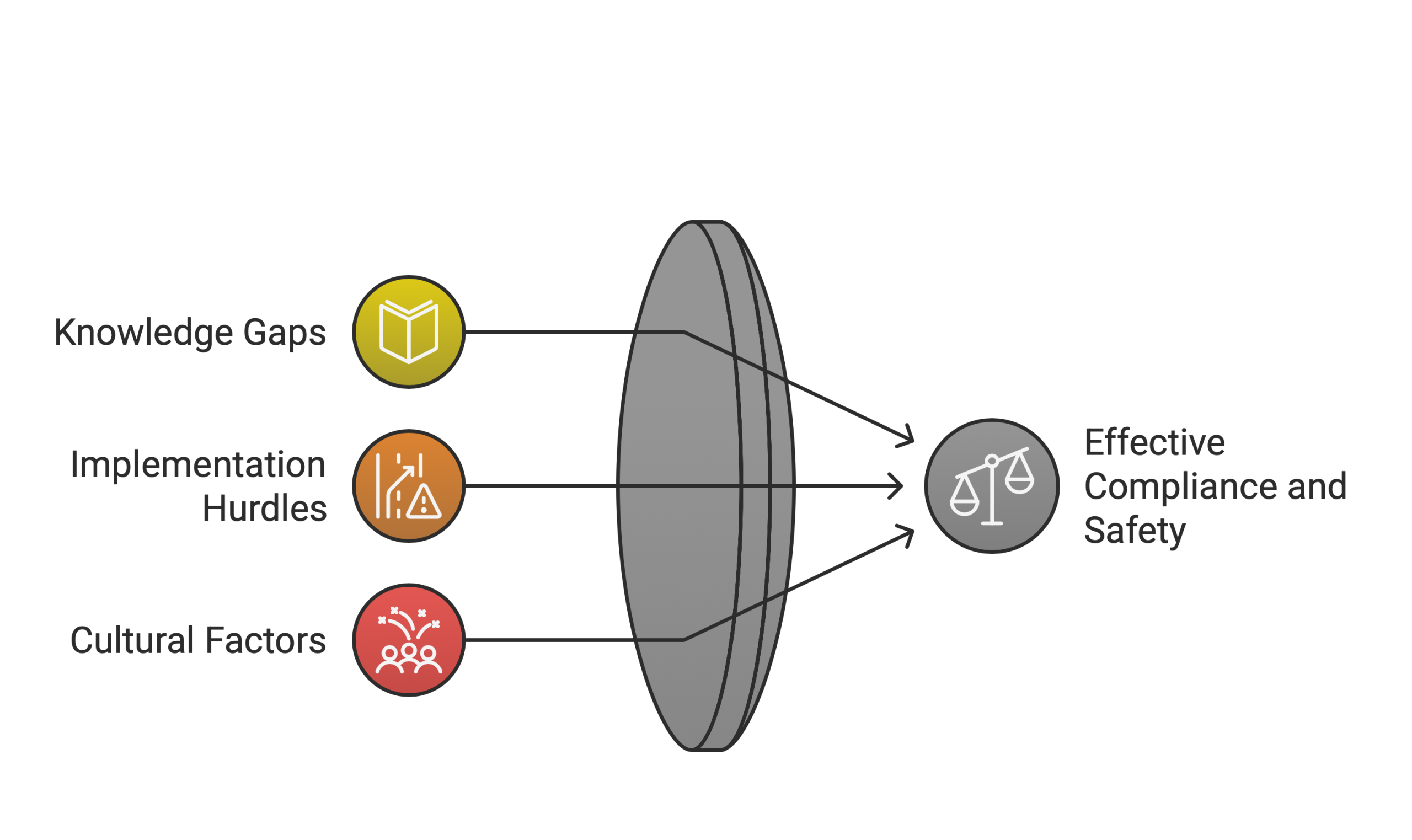
Even organizations committed to lone worker safety encounter significant implementation hurdles. Understanding these challenges helps develop more effective solutions compliant with relevant laws.
Awareness Gaps: The Knowledge Deficit in Lone Worker Law
Many organizations, particularly smaller businesses, lack full awareness of their legal obligations under lone worker compliance law. Common misconceptions include:
- Assuming general worker safety measures adequately protect lone workers
- Believing cell phone access alone provides sufficient protection under the law
- Underestimating legal requirements during “brief” periods of working alone
- Misinterpreting jurisdictional requirements for lone worker protection
Educational initiatives addressing these knowledge gaps represent the first step toward meaningful compliance with lone worker laws.
Operational Difficulties: When Compliance Systems Meet Reality
💡 Common Scenario:
A transportation company implemented manual check-in calls every two hours for drivers. During busy periods, supervisors often missed making these calls, creating significant legal exposure. After implementing an automated system, they eliminated check-in failures and enhanced driver safety.
Implementing check-in systems required by lone worker compliance law creates practical challenges:
- Workers forgetting scheduled check-ins during busy periods
- Supervisors becoming overwhelmed with monitoring responsibilities
- Manual systems failing due to human inconsistency
- After-hours and weekend coverage creating scheduling difficulties
- Safety protocols being bypassed during high-pressure situations
These operational realities often create compliance gaps between written procedures and actual practice, potentially leaving organizations exposed to legal liability.
Technology Limitations: When Communication Fails Despite Legal Requirements
Many work environments present significant communication barriers that complicate compliance with lone worker laws:
- Rural and remote areas with limited cellular coverage
- Buildings with signal-blocking construction
- Equipment failures at critical moments
- Complex technology creating user resistance
- False alarms reducing system credibility
Finding reliable communication solutions for diverse environments requires testing and often multiple technologies for different scenarios to achieve legal compliance.
Cultural Resistance: The Human Factor in Lone Worker Law Compliance
Worker attitudes toward safety measures significantly impact effectiveness of lone worker protection programs:
Creating a positive safety culture where workers value and follow lone worker protocols requires leadership commitment and ongoing reinforcement of legal obligations.
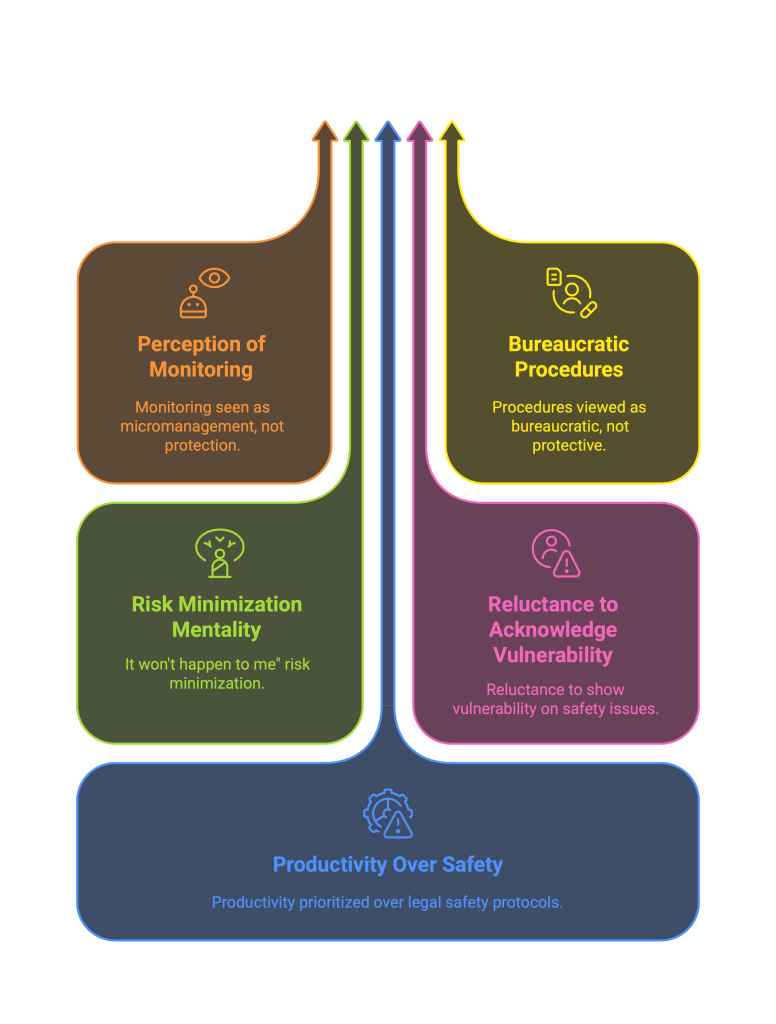
Administrative Burden: The Documentation Challenge of Lone Worker Compliance Law
Compliance with lone worker laws creates substantial administrative requirements:
- Tracking check-ins across multiple workers and shifts
- Maintaining current hazard assessments for various scenarios
- Keeping training records updated as staff changes
- Investigating and documenting safety incidents
- Creating audit-ready compliance documentation
Without proper systems, administrative overload can lead to shortcuts that compromise protection and legal compliance.
Lone Worker Compliance Law: Answering Your FAQs
Key Takeaways:
- Common Questions: Employers frequently have similar questions about legal requirements.
- Provincial Variations: Answers often depend on your specific provincial jurisdiction.
- Practical Focus: Understanding how to apply regulations in real-world situations is critical.
Can you legally work alone in Ontario?
Yes, you can legally work alone in Ontario. Unlike some provinces, Ontario doesn’t have regulations specifically prohibiting lone work. However, under Section 25(2)(h) of Ontario’s Occupational Health and Safety Act, employers must “take every precaution reasonable in the circumstances for the protection of a worker.” This general duty clause means employers must assess risks associated with lone work and implement appropriate safeguards.
What are the 3 A’s in dynamic risk assessment for lone workers?
The 3 A’s in dynamic risk assessment for lone workers are: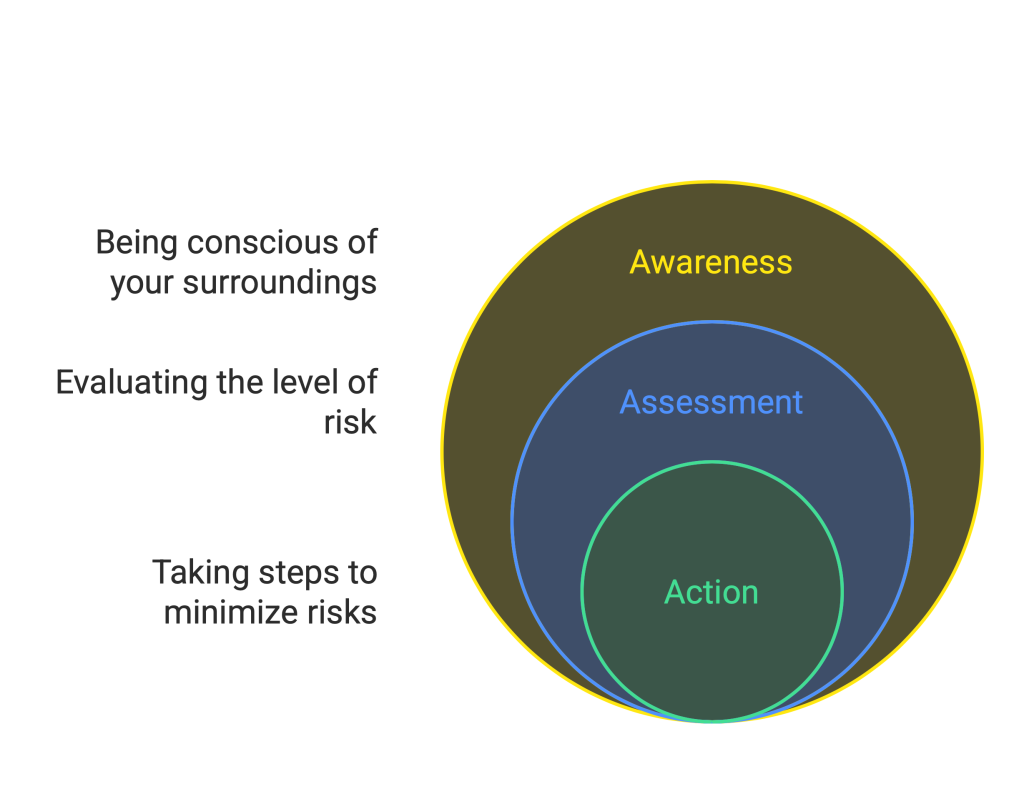
- Awareness: Being conscious of your surroundings, potential hazards, and changing conditions
- Assessment: Evaluating the level of risk present in your current situation
- Action: Taking appropriate steps to minimize or eliminate identified risks
This approach enables lone workers to continually evaluate their safety as conditions change during their shift or assignment.
What is considered working alone under OHS legislation?
Under most Canadian OHS legislation, “working alone” is defined as working in circumstances where assistance is not readily available in case of emergency, injury, or illness. Specifically, this typically means:
- Being the only worker at a worksite or in a specific area
- Working in a location where the worker cannot be seen or heard by another person
- Working in situations where assistance would not be readily available if needed
Different provinces may have slight variations in their definitions, but these core elements are generally consistent across Canadian jurisdictions.
Are line managers responsible for writing lone working policies?
While line managers may contribute to lone working policies, the ultimate responsibility for creating and implementing these policies rests with the employer. Line managers often play a critical role in:
- Providing input based on operational realities
- Implementing policies within their departments
- Ensuring workers understand and follow procedures
- Monitoring compliance with established protocols
- Recommending improvements based on field experience
Best practice suggests a collaborative approach where safety professionals, management, and workers all contribute to developing effective lone working policies that meet legal requirements.
How many hours straight can you legally work in Ontario?
Under Ontario’s Employment Standards Act, employees can work up to:
- 8 hours per day (or the number of hours in a regular workday, if greater)
- 48 hours per week
However, with proper agreements in place, employees may work up to 60 hours per week. Since 2019, approval from the Director of Employment Standards is no longer required for up to 60 hours—only employer and employee agreement is needed. Approval is required only to exceed 60 hours per week.
What two laws are in place in Ontario to protect employees in the workplace?
The two primary laws protecting employees in Ontario workplaces are:
- Occupational Health and Safety Act (OHSA): This comprehensive legislation sets out the rights and duties of workplace parties to ensure safe and healthy work environments. It establishes procedures for dealing with workplace hazards and provides for enforcement where compliance is not achieved voluntarily.
- Employment Standards Act (ESA): This act establishes minimum standards for employment including working hours, minimum wage, overtime pay, leaves of absence, and termination notice requirements.
Together, these laws create a framework for protecting workers’ safety, health, and basic employment rights in Ontario.
How many hours are you legally allowed to work in a day in Canada?
Work hour limits vary by province in Canada, as labour laws are primarily provincial jurisdiction. Generally:
- Most provinces set standard work days at 8 hours
- Standard work weeks typically range from 40-48 hours
- Many jurisdictions require overtime pay after 8 hours per day or 40-44 hours per week
- Some provinces allow for averaging agreements that modify these standards
For lone workers, employers should consider whether extended hours increase risk, especially in remote or hazardous environments. Fatigue can significantly impact a lone worker’s ability to respond to emergencies.
What are the disadvantages of lone working?
💡 IMPORTANT
These disadvantages highlight why specific lone worker protections are necessary beyond standard safety measures. Recognizing these challenges is the first step in developing effective compliance strategies.
The disadvantages of lone working include:
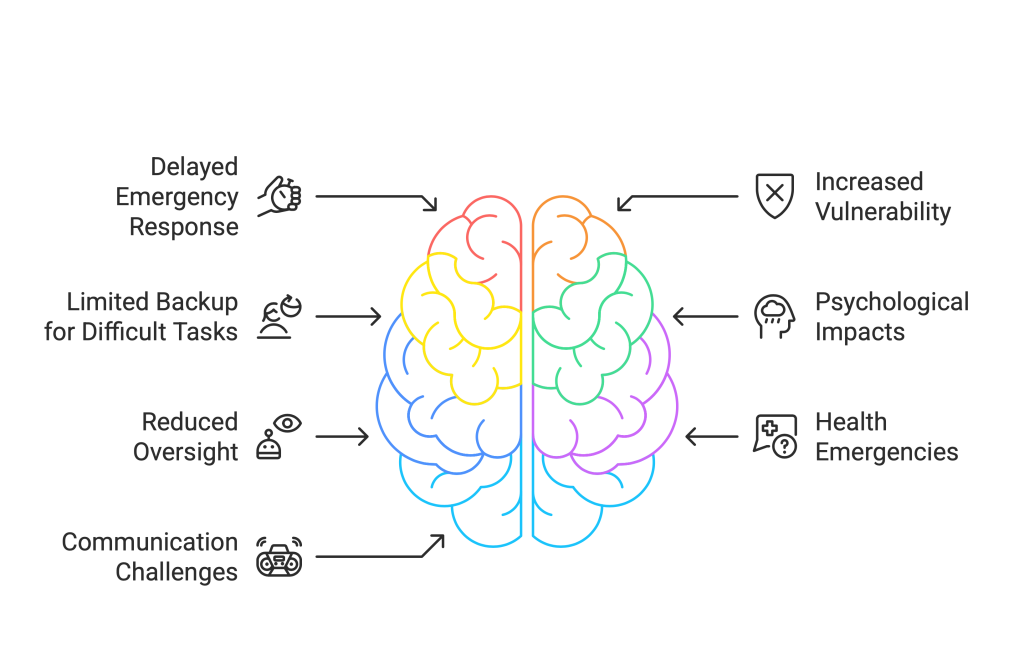
- Delayed emergency response: If an incident occurs, help may not arrive promptly
- Increased vulnerability: Lone workers may be more susceptible to violence, especially in public-facing roles
- Limited backup for difficult tasks: Some work is inherently safer with two people
- Psychological impacts: Isolation can lead to stress, anxiety, or poor decision-making
- Reduced oversight: No direct supervision means potential hazards might go unnoticed
- Health emergencies: Medical conditions can become more dangerous when no one is available to assist
- Communication challenges: Technical failures in communication systems can leave lone workers truly isolated
These disadvantages underscore why lone worker compliance laws require appropriate safeguards and monitoring systems.
How many days can you work without a day off in Ontario?
Under Ontario’s Employment Standards Act, employees must receive at least 24 consecutive hours off work in each work week, or 48 consecutive hours off in every two-week period. This means an employee could potentially work up to 12 consecutive days before requiring a day off (if using the two-week period option).
For lone workers, especially those in high-risk or physically/mentally demanding roles, employers should consider whether consecutive workdays increase fatigue and risk levels, even if technically permitted by employment standards.
Compliance Checklist & Best Practices
Key Takeaways:
- Structured Approach: Following a methodical compliance process helps ensure all legal requirements are met.
- Documentation: Maintaining comprehensive records is essential for demonstrating due diligence.
- Regular Review: Compliance is an ongoing process requiring periodic updates and improvements.
Use this checklist to assess your organization’s compliance status with Canadian lone worker laws:
Comprehensive Compliance Checklist
| Category | Compliance Items | Status |
| 1. Risk Assessment | ✓ Cataloged all lone worker scenarios covered by law
✓ Documented who works alone, when, and where ✓ Included all departments and job functions ✓ Captured less obvious situations (travel, after-hours work) ✓ Conducted formal risk assessments for all lone work ✓ Documented specific hazards by scenario ✓ Evaluated both probability and potential severity ✓ Engaged workers and safety committees in the process ✓ Prioritized high-risk situations for immediate action |
□ □ □ □ □ □ □ □ □ |
| 2. Legal Review | ✓ Examined lone worker compliance laws in all relevant jurisdictions
✓ Identified specific requirements by location ✓ Created necessary documentation ✓ Scheduled required reviews and updates |
□ □ □ □ |
| 3. Policies and Procedures | ✓ Developed comprehensive lone worker safety policy
✓ Created detailed procedures for each scenario ✓ Established appropriate check-in protocols ✓ Documented emergency response procedures ✓ Clarified responsibilities for all parties |
□ □ □ □ □ |
| 4. Communication Systems | ✓ Selected appropriate technology for each environment
✓ Implemented reliable check-in mechanisms ✓ Tested all systems under actual work conditions ✓ Established backup communication plans ✓ Documented proper usage procedures |
□ □ □ □ □ |
| 5. Training Program | ✓ Trained lone workers on hazards and procedures
✓ Provided hands-on practice with safety tools ✓ Educated supervisors on monitoring responsibilities ✓ Conducted emergency response simulations ✓ Documented all training activities |
□ □ □ □ □ |
| 6. Emergency Response Planning | ✓ Developed scenario-specific response procedures
✓ Established clear escalation paths ✓ Created contact lists with redundancy ✓ Determined emergency service engagement criteria ✓ Validated protocols through realistic drills |
□ □ □ □ □ |
| 7. Documentation System | ✓ Maintained hazard assessment records
✓ Logged all training activities ✓ Recorded check-ins and exception handling ✓ Documented incidents and resolutions ✓ Created comprehensive compliance audit trail |
□ □ □ □ □ |
| 8. Review Process | ✓ Scheduled regular system testing
✓ Conducted post-incident reviews ✓ Updated procedures based on operational feedback ✓ Performed annual comprehensive program evaluation ✓ Monitored regulatory developments and lone worker compliance law changes |
□ □ □ □ □ |
Conclusion: A Strategic Approach to Lone Worker Compliance Law
Key Takeaways:
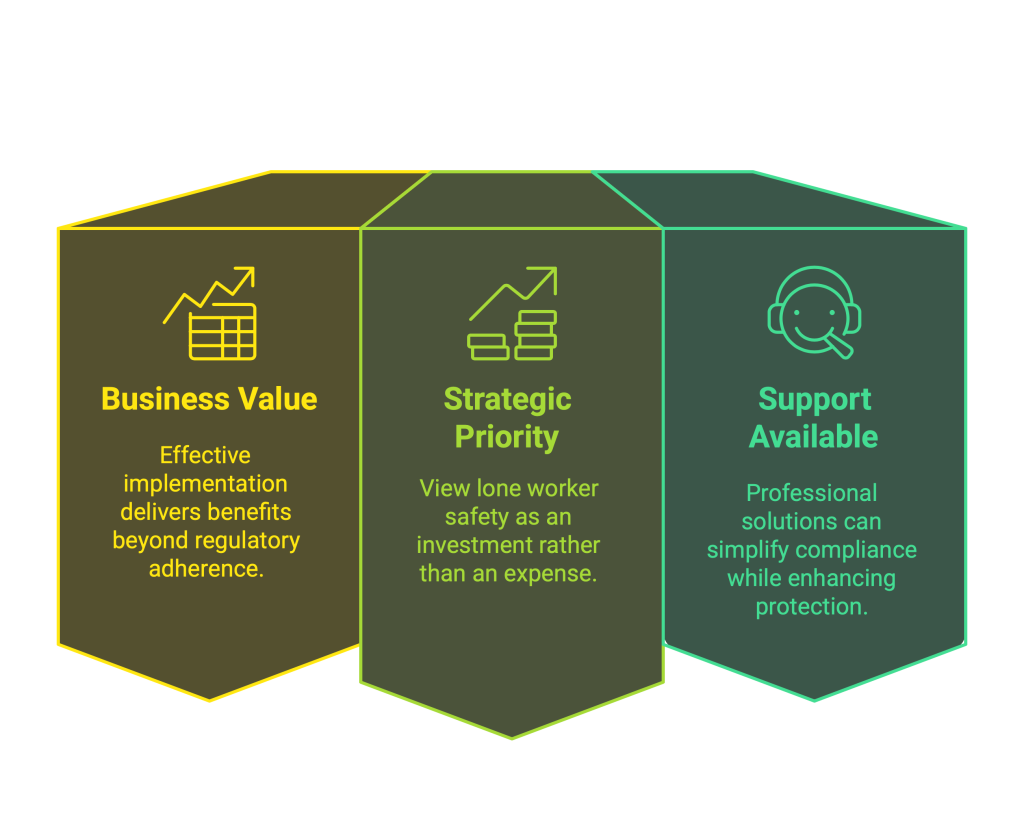
- Business Value: Effective implementation delivers benefits beyond regulatory adherence.
- Strategic Priority: View lone worker safety as an investment rather than an expense.
- Support Available: Professional solutions can simplify compliance while enhancing protection.
Navigating lone worker compliance law isn’t the most exciting part of running a business. But effective implementation delivers benefits far beyond regulatory adherence. Organizations that implement comprehensive protection programs experience measurable advantages: reduced incidents, lower insurance costs, improved recruiting and retention, and enhanced operational confidence.
The key to success lies in viewing lone worker compliance law as a strategic business priority rather than a regulatory burden. Consider it an investment rather than an expense. By implementing appropriate technologies, clear procedures, and ongoing monitoring, you create a protective framework that enables your lone workers to perform their essential functions with confidence and security.
For decision-makers seeking to strengthen their lone worker protection programs, Protelec CheckMate offers a proven solution specifically designed for Canadian lone worker compliance law requirements. Our comprehensive system combines cutting-edge technology with professional monitoring to create a seamless safety net for your lone workers while simplifying your compliance efforts.
If you’re searching for the best lone worker app in 2025, look for features like real-time GPS tracking, automated check-ins, man-down detection, and direct emergency alert capabilities.
Contact Protelec CheckMate today to discuss how our customized lone worker solutions can enhance your safety program while reducing your administrative burden and compliance risk.
Building Your Legally Compliant Lone Worker Protection Program
Key Takeaways:
- Systematic Approach: Creating an effective program requires methodical planning and implementation.
- Risk-Based Priorities: Focus first on high-risk situations while developing comprehensive coverage.
- Integration: The most successful programs incorporate lone worker safety into overall operations rather than treating it as a separate function.
Whether implementing CheckMate or developing internal systems, follow this structured approach to create a lone worker safety program that meets all legal requirements:
1. Map Your Lone Worker Landscape Under the Law
Begin with comprehensive identification of when, where and how employees work alone:
- Regular lone shifts or assignments
- Travel between work locations
- Early arrivals and late departures
- Maintenance activities outside normal hours
- Client site visits and fieldwork
- Remote work from isolated locations
Ask: “Would another worker immediately notice if something went wrong?” If not, you’ve identified a lone worker scenario requiring protection under Canadian law.
2. Perform Legally Required Risk Assessment
For each identified scenario, evaluate hazards considering:
- Physical environment (heights, confined spaces, temperature extremes)
- Location factors (isolation, crime risk, accessibility)
- Task hazards (equipment, chemicals, electricity)
- Violence or harassment potential
- Environmental variables (weather, wildlife, lighting)
- Communication limitations (connectivity, noise)
Rate scenarios by risk level to prioritize your implementation efforts and demonstrate legal due diligence.
3. Understand Applicable Lone Worker Compliance Laws
Review the specific requirements in each jurisdiction where your employees work:
- Explicit lone worker provisions
- Documentation mandates
- Training requirements
- Check-in protocol specifications
- Equipment standards
- Review and inspection frequencies
Create a jurisdiction-specific compliance checklist to ensure your program meets all relevant legal standards for lone worker protection.
4. Develop Legally Required Documentation
Create clear written materials covering:
- Organizational definition of lone working
- Identified hazards and corresponding controls
- Activities prohibited when working alone
- Communication expectations and check-in requirements
- Response procedures for missed check-ins
- Emergency protocols with escalation paths
- Role-specific responsibilities
Use clear language supplemented with visual aids like flowcharts for emergency procedures to ensure your documentation satisfies legal requirements.
5. Select Appropriate Technology for Legal Compliance
Choose solutions matching your specific operational needs and legal obligations:
- Mobile applications for workers with smartphones in connected areas
- Radio systems for locations with poor cellular coverage
- Satellite communication for truly remote operations
- Personal alarm devices for high-risk environments
- Fixed emergency buttons for stationary locations
- Monitoring systems or services for 24/7 oversight
Test all technologies in actual work environments before full deployment to identify limitations or incompatibilities that could create legal exposure.
6. Deliver Legally Mandated Training
Ensure all stakeholders receive appropriate instruction as required by law:
- Lone workers (hazards, procedures, technology usage)
- Supervisors (monitoring responsibilities, emergency response)
- Monitoring personnel (escalation protocols, communication)
- Management (legal obligations, program oversight)
Include hands-on practice with devices and emergency scenario drills to build practical competence beyond theoretical knowledge and fulfill training requirements under lone worker laws.
7. Verify Legal Compliance of Your System
Regularly test your lone worker protection mechanisms to ensure ongoing compliance:
- Simulate missed check-ins to verify response
- Evaluate backup communication methods
- Verify emergency contact information currency
- Confirm monitoring personnel follow protocols correctly
- Time emergency responses to identify improvement opportunities
Document test results and address any identified weaknesses to demonstrate continuous compliance with lone worker laws.
8. Commit to Continuous Legal Compliance
Safety and legal compliance require ongoing attention. Schedule regular program reviews:
- Following any incident or near-miss
- When introducing new work processes or locations
- At minimum annually (more frequently for high-risk operations)
- In response to regulatory changes
- When new technology becomes available
Include lone workers in these reviews to capture frontline perspectives on challenges and potential solutions while maintaining documentation of your compliance efforts.## How ProTELEC CheckMate Simplifies Lone Worker Law Compliance
Key Takeaways:
- Automated Solution: CheckMate eliminates manual check-in inconsistencies with reliable automation.
- Emergency Response: Multiple alert options and professional monitoring ensure rapid assistance.
- Comprehensive Approach: From implementation to documentation, CheckMate addresses all compliance requirements.
Protelec CheckMate is a complete lone worker protection system, helping organizations across Canada meet their legal requirements through automation, monitoring, and reporting.
Automated Check-In Management: Legal Compliance Without Complexity
💡 Success Story
A transportation client previously relied on supervisors calling drivers every two hours—but during busy periods, these calls were frequently missed, creating legal exposure. After implementing CheckMate’s automated system, they eliminated check-in failures while their drivers reported enhanced security during remote routes, achieving both practical safety and legal compliance.
CheckMate eliminates the inconsistency of manual check-in systems through:
- Automated reminders that don’t depend on memory
- Customizable intervals based on risk assessment requirements and specific roles
- Intelligent escalation when check-ins are missed
- Seamless integration with existing workflows
Our lone worker monitoring app allows employers to automate check-ins, track user activity, and customize safety settings across different job roles and risk levels.
Versatile Emergency Alert Options: Legal Protection for Every Scenario
Different emergencies require different response mechanisms to meet lone worker law requirements. CheckMate provides:
- Mobile app SOS functionality for immediate assistance
- Automatic man-down detection for falls or immobility
- Discreet duress options for sensitive situations
- Emergency panic button for workers — ideal for high-risk roles that require instant, visible alerts during emergencies
CheckMate functions as a reliable remote worker emergency alert system, designed for immediate escalation and real-time coordination.
A social services agency equipped field staff with our duress feature, allowing a case worker during an increasingly hostile home visit to trigger a silent alert that brought police assistance without escalating the confrontation—potentially preventing violence while meeting their legal duty of care.
Location Intelligence: Legal Precision When Time Matters
In emergencies, exact location information saves critical minutes and helps meet legal obligations. Our lone worker GPS tracking app provides real-time positioning and route history, offering precision when it matters most. CheckMate delivers:
- Real-time GPS mapping showing worker positions
- Movement tracking to identify unusual patterns
- Geofencing capability defining safety boundaries
- Location history for incident investigation and legal documentation
- Functionality in remote areas with limited connectivity
This capability proved life-saving when a utility company using our system dispatched emergency services to a technician’s precise location during a cardiac event at a rural substation, eliminating the delay of searching a large facility while demonstrating proper lone worker law compliance.
Professional Monitoring: Continuous Legal Protection
Organizations without 24/7 internal monitoring capability benefit from:
- ULC-certified, Five Diamond-certified Canadian-based Emergency Monitoring Centre
- 24/7 trained operators following your specific protocols
- Multilingual support for diverse workforces
- Managed escalation until resolution
This service particularly benefits smaller companies without internal monitoring resources and operations with overnight shifts when supervisors may be unavailable, helping them achieve lone worker law compliance without major infrastructure investments.
Compliance Documentation: Legal Validation Made Simple
CheckMate automatically generates the documentation needed to demonstrate regulatory compliance with lone worker laws:
- Comprehensive usage reports confirming check-in adherence
- Incident logs with detailed timestamps and resolutions
- User activity summaries identifying potential training needs
- Regulatory-ready reports suitable for inspections
As a complete lone worker compliance software solution, CheckMate simplifies the reporting and documentation process for organizations of all sizes.
These reports both satisfy documentation requirements under lone worker compliance law and provide insights for program improvement. Clients have used our analytics to identify risk patterns at specific locations or times, allowing targeted enhancement of safety protocols while maintaining continuous legal compliance.
Streamlined Implementation: From Legal Requirement to Reality
CheckMate’s implementation process ensures rapid adoption and sustained usage:
- Customized setup matching your specific compliance requirements
- Schedule-based auto-activation eliminating startup errors
- Intuitive interfaces minimizing training requirements
- Comprehensive implementation support
Our structured approach creates a smooth transition from existing systems (or no system) to a comprehensive protection program satisfying regulatory requirements without operational disruption while ensuring continuous compliance with lone worker laws.
This article provides general information about lone worker compliance law in Canada. For specific legal advice regarding your organization’s obligations, please consult qualified legal counsel familiar with the regulations in your jurisdiction.
Federal and Provincial OHS Regulations
Federal
- Canada Labour Code, Part II
- Canada Occupational Health and Safety Regulations
- Canadian Centre for Occupational Health and Safety (CCOHS)
British Columbia
Alberta
Saskatchewan
Manitoba
Ontario
Quebec
New Brunswick
Nova Scotia
Prince Edward Island
Newfoundland and Labrador
Yukon
Northwest Territories and Nunavut
Please note that government websites frequently reorganize their content, so some of these links may need to be updated. If you encounter broken links, I would recommend searching for the legislation name on the provincial government website or using CanLII (Canadian Legal Information Institute) at www.canlii.org which maintains current versions of all Canadian legislation.

